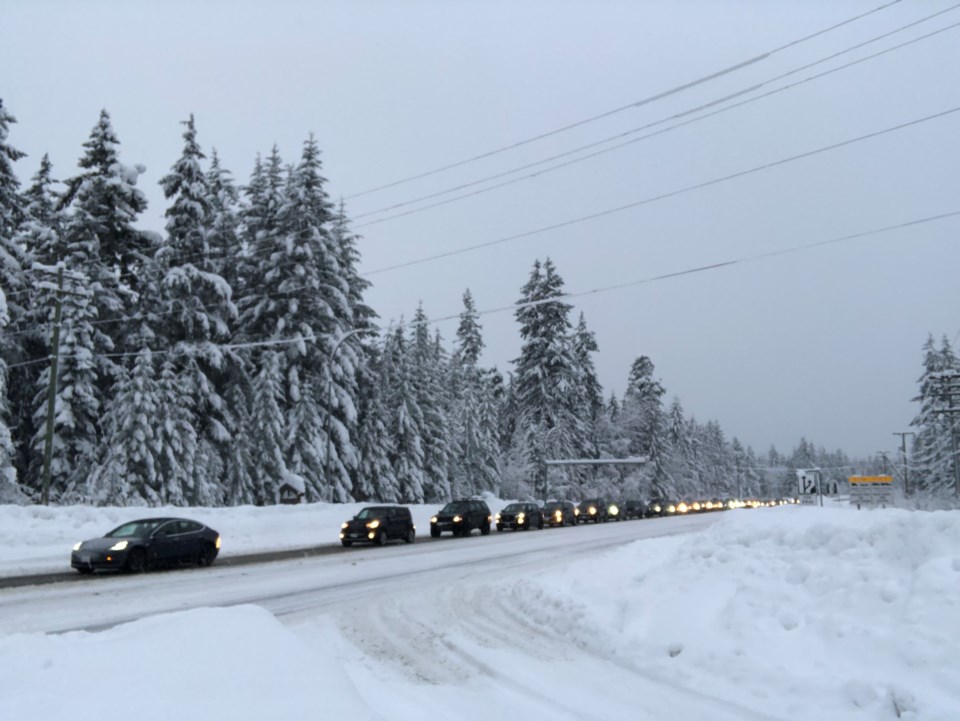As an elected official, particularly one in a community with as passionate a population as Whistler, you tend to get a lot of messages from your constituents. But even Councillor Ralph Forsyth was taken aback when he checked his inbox after the recent string of traffic delays on Highway 99.
“I’ve never had so many emails,” he said. “As long as people know that we get it, we don’t want this either and we’re doing everything we can.”
Between the seemingly endless snowfall and icy conditions wreaking havoc during Whistler’s usual busy holiday period, major disruptions to several Whistler Transit routes, and the closure of other major B.C. highways pushing motorists to the resort, the past few weeks have proven to be a “perfect storm” of conditions on local roads, Forsyth said.
While traffic volumes over the holidays were below pre-pandemic levels, according to the Resort Municipality of Whistler (RMOW), local police responded to 13 per cent more collisions than they did in the same period in 2019-20, and 60 per cent more than last year’s holidays.
For local Patrick Smyth, that’s meant up to three-hour delays for his fine food delivery company based out of Richmond, and an hour delay from the indoor vertical farm he’s a part of in Pemberton’s industrial park.
“From a business perspective, it’s a pain,” he said. “The other day I had a delivery … and the chef was like, ‘Paddy, where are you?’ I was on West Side [Road]. I couldn’t even get through the highway. So it was faster for me to take West Side just to do a delivery.
“So from a business point of view, it’s impacted our delivery times, our scheduling and then we’re idling on the road.”
Mayor Jack Crompton heard about similar troubles from numerous Whistlerites in recent weeks, and said he has brought up the issue personally to B.C.’s Ministry of Transportation, responsible for highways in the province, pushing once more for improvements to highway infrastructure, as well as action on a proposed regional transit system that has been on the table for years. The mayor has also requested that municipal staff bring a road management report to the next council meeting on Jan. 25, and intends to ask the RMOW’s Transportation Advisory Group (TAG) to update its previous work on Highway 99.
“We know the highway won’t fix itself,” Crompton said at the Jan. 11 council meeting. “We need to continue to work with the province and be a part of finding appropriate mechanisms that we can implement to help address traffic volumes.”
Crompton noted that officials can’t be narrow-minded when considering solutions.
“I’m convinced we need to take this on with both a short-term and a long-term view in mind as the Lower Mainland and the Sea to Sky continue to grow,” he said.
One short-term solution some residents online have pointed to is bringing back the traffic-flagging program that was implemented at busy intersections in the winter of 2016-17, a joint initiative between the RMOW and Whistler Blackcomb.
According to the RMOW’s analysis, however, the program actually added to the congestion.
“The 2017 program was a success from the public perception perspective, but unfortunately it didn’t provide higher vehicle throughput. In fact, the data showed that the traffic actually moved more slowly when flaggers operated at intersections,” Crompton said.
One of the RMOW’s preferred approaches is introducing a transit queue jumper lane on the highway, which would help incentivize transit ridership, Crompton said.
“In my view, the best incentive to encourage people to ride the bus is to make the bus a more efficient mode of transportation,” he said. “Certainly if there was a way for the bus to bypass traffic, many of us would have considered it as a preferred option to being in vehicles [during the recent traffic jams].”
Taking a longer view, Forsyth, who also sits on TAG, said future strategies will likely lie in emerging technologies, like autonomous vehicles.
“I don’t think it’s the solutions we’ve thought of to date,” he said. “I don’t think we’re in the time and place for that solution to solve our problems; it’s going to be something we haven’t thought of yet. Or some emerging technology that is not readily available.”
Of course, that is cold comfort for the scores of Whistlerites that have gotten stuck in crawling traffic in recent weeks.
“The No. 1 solution, and people don’t want to hear this, but it’s get on the bus,” Forsyth said. “If we were all on a bus, then that’s probably a quarter of the traffic right there.”




